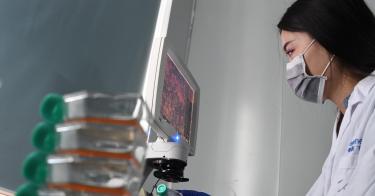It’s no longer a “conspiracy theory.” There’s growing evidence that COVID-19 probably originated in a lab in Wuhan, China, and not from a viral transmission from an animal to a human in nature.
The Wall Street Journal reports, based on the most recent intelligence, such is the considered judgment of senior analysts at the U.S. Department of Energy, as well as at the FBI.
If true, that Chinese lab leak unleashed a deadly global pandemic that killed nearly 7 million people, including more than 1.1 million Americans.
Communist Chinese officials insisted the pandemic originated in “nature.” Their stubborn refusal to cooperate with international research teams to provide relevant information has hindered the production of definitive evidence concerning the pandemic’s origins.
Beijing has instead perpetuated conflict and division within scientific and governmental circles in the West. In February 2020, the World Health Organization, which faced restricted access to the Wuhan lab, nonetheless concluded that the coronavirus had a natural origin. In 2021, President Joe Biden’s Office of National Intelligence report on the pandemic’s origins was inconclusive. Among scientists, the debate on the origins remains unresolved.
Given the pandemic’s massive death and economic destruction (an estimated $10 trillion), Congress must pursue an inquiry into COVID-19’s origins. As difficult as it will prove to be, that probe must be aggressive and deep.
Congress must not only determine what federal officials knew, and when they knew what they knew, but also correct any deficiencies in America’s response to prepare for the next public health crisis. As analysts with the Government Accountability Office observe, “This understanding could help inform preparation and response to future epidemics and pandemics.”
The Select Subcommittee on the Coronavirus Pandemic of the House of Representatives, chaired by Rep. Brad Wenstrup, R-Ohio, will soon hold its first public hearings on the topic. The subcommittee should not only summon Energy Department and FBI analysts to testify on their recent assessments, but also officials of the State Department who issued a similar assessment of the origins of COVID-19 during the early stages of the pandemic in April 2020.
Examining five potential scenarios, State Department officials then concluded, “There is no direct, smoking gun evidence to prove that a leak from Wuhan labs caused the pandemic, but there is circumstantial evidence to suggest such is the case.” State Department officials then further noted that Chinese authorities sealed off the Wuhan lab in January 2020, and Huang Yanling, a lab employee rumored to be “patient zero,” disappeared.
Debunking “Conspiracy Theory”
Beginning on Jan. 3, 2020, Chinese communist officials, while insisting on the natural origin of the coronavirus, forbade the release of any information related to the pandemic without government approval. Nonetheless, America’s top federal public health officials, National Institutes of Health Director Francis Collins and Dr. Anthony Fauci, seemed morally certain that COVID-19 had a natural origin and NIH-funded scientists fell into line.
For example:
On March 7, 2020, The Lancet, a prestigious British medical journal, published a remarkable letter proclaiming “solidarity” with Chinese colleagues combating COVID-19 and decrying “conspiracy theories” that hinder international cooperation. The letter was signed by 26 scientists, including Peter Daszak, president of EcoHealth Alliance, the firm that had worked closely with the Wuhan Institute of Virology and had received $8 million in American taxpayer funding.
On March 17, 2020, Nature Medicine, a professional journal, published an article concluding that the novel coronavirus was not a “laboratory construct.” That article was signed by six scientists, including Dr. Kristian Andersen of the Scripps Research Institute, another recipient of substantial NIH funding.
On March 26, 2020, NIH chief Collins followed up with a blog post, highlighting the March 17 Nature Medicine article, and condemning “outrageous” claims that the novel coronavirus was engineered in a lab.
Following this aggressive public relations offensive, in an April 2020 email, Collins told Fauci that they still had to find some way to “put down this very destructive conspiracy.” Collins warned that the emergence of the “lab leak” theory could damage “science and international harmony.” Fauci responded that the lab leak theory was a “shiny object” that would fade with time.
“Gain of Function” Controversy
Viral “gain of function” research—that is, research that genetically engineers a virus to make it more lethal and more transmissible—is a critical piece of the puzzle.
In sworn testimony before the Senate last year, Fauci steadfastly denied that NIH funded “gain of function” research in China. In recent sworn testimony before the House of Representatives, Dr. Lawrence Tabak also denied that NIH had funded such research.
Yet, the April 2020 State Department memo makes clear: Dr. Shi Zheng Li—the so-called Bat Woman of China—“conducted genetic engineering of bat virus to make it easily transmissible to humans.” Shi functioned as a “subcontractor” of EcoHealth Alliance, the firm that had gotten substantial grant funding from NIH and also collaborated with Dr. Ralph Baric of the University of North Carolina, as well as other scientists, on research (reviewed by the NIH) into the potential of bat coronaviruses to infect humans.
Key Questions
From a practical perspective, lawmakers drilling down on the pandemic’s origins need to enlist the assistance of scientists who specialize in evolutionary virology in assessing the evidence. They must also call prominent independent virologists, especially those who have been publicly engaged on the issue, to provide congressional testimony.
Furthermore, lawmakers must also determine what role, if any, that federal officials may have played in funding research that might have contributed to the pandemic.
Among the key questions:
- If the novel coronavirus emerged in nature, is there any hard evidence of any animal having SARS-CoV-2 before the first cases of human infection?
- With the shutdown of any information coming out of Communist China without government approval on Jan. 3, 2020, how could federal health officials—particularly Collins and Fauci—be morally certain that the pandemic was not the product of a lab leak? Had they come into possession of any scientifically verifiable evidence since January 2020 to support such a conclusion?
- What new evidence did Scripps’ Andersen and Robert Garry of Tulane Medical School, both of whom expressed strong skepticism about the natural origins of the coronavirus to NIH officials, have in their possession that caused them to change their initial assessment?
- Did either Collins or Fauci, or anyone on their staffs, suggest, encourage, provide comments to, or review the multiple authors’ correspondence in The Lancet or the article in Nature Medicine?
- How many of the 26 authors of The Lancet correspondence, or the six authors of the Nature Medicine article, had then been recipients of NIH grant funding?
- Given NIH’s poor oversight, plus the failure of EcoHealth Alliance to provide NIH with timely information on the Wuhan experiments, as Rep. Debbie Lesko, R-Ariz., has observed, how could federal officials know for sure that there was no taxpayer funding of “gain of function” research?
- When NIH officials were debunking the lab leak theory as a “conspiracy theory” in April 2020, were they also aware that State Department personnel had arrived at a very different conclusion at roughly the same time? Given the gravity of the subject, was there sufficient interagency communication? Was the White House made aware of these divergent assessments among career civil servants?
As for Fauci’s “shiny object,” it just got brighter.
If top NIH officials and their media allies had hoped to dismiss the laboratory origins of the novel coronavirus as a silly “conspiracy theory,” they clearly failed.
Bolstered by new intelligence, analysts at the Department of Energy and at the FBI have reinforced the initial assessment of State Department personnel made three years ago: The “circumstantial evidence” indicated that the pandemic emerged from a lab.
Congress must keep digging.
This piece originally appeared in The Daily Signal




